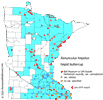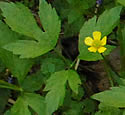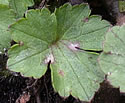Ranunculus hispidus (Hispid Buttercup)
| Also known as: | Bristly Buttercup, Swamp Buttercup, Marsh Buttercup |
|---|---|
| Genus: | Ranunculus |
| Family: | Ranunculaceae (Buttercup) |
| Life cycle: | perennial |
| Origin: | native |
| Habitat: | part shade; moist woods, seeps, along streams |
| Bloom season: | April - June |
| Plant height: | 6 to 18 inches |
| Wetland Indicator Status: | GP: FACW MW: FAC NCNE: FAC |
| MN county distribution (click map to enlarge): |  |
| National distribution (click map to enlarge): |  |
Pick an image for a larger view. See the glossary for icon descriptions.
Detailed Information
Flower: 
![[photo of flower]](/udata/r9ndp23q/pd/ranunculus-hispidus-003-t.jpg) A single flower at the end of a long, hairy but otherwise naked stalk that arises from some leaf axils in the upper part of the plant. Flowers are ¾ to 1¼ inches across with 5 shiny, yellow, generally oval petals and numerous yellow stamens surrounding a green center. The base of the petals is greenish with streaks that serve as nectar guides for visiting insects. The 5 yellowish to light green sepals behind the flower are shorter than the petals, by as much as half, and may be spreading or bent back away from the flower (reflexed).
A single flower at the end of a long, hairy but otherwise naked stalk that arises from some leaf axils in the upper part of the plant. Flowers are ¾ to 1¼ inches across with 5 shiny, yellow, generally oval petals and numerous yellow stamens surrounding a green center. The base of the petals is greenish with streaks that serve as nectar guides for visiting insects. The 5 yellowish to light green sepals behind the flower are shorter than the petals, by as much as half, and may be spreading or bent back away from the flower (reflexed).
Leaves and stem: 




![[photo of leaves]](/udata/r9ndp23q/yellow/hispid-buttercup_0523_104601-t.jpg) Both basal and alternate stem leaves are compound in groups of 3, becoming smaller as they ascend the stem, though some basal leaves may be simple lobed, especially the early growth. Leaflets are cleft or lobed, usually in 3 parts, up to 3 inches across and wide, with irregular teeth around the edges, on stalks covered in long hairs, and usually with a wedge-shaped base. The end leaflet is largest and basal leaves have the longest stalks. Leaves are hairy to varying degrees, especially along major veins on the underside. Stems are hairy. The plant grows erect or sprawling but rising at branch tips (decumbent), sometimes rooting at the nodes.
Both basal and alternate stem leaves are compound in groups of 3, becoming smaller as they ascend the stem, though some basal leaves may be simple lobed, especially the early growth. Leaflets are cleft or lobed, usually in 3 parts, up to 3 inches across and wide, with irregular teeth around the edges, on stalks covered in long hairs, and usually with a wedge-shaped base. The end leaflet is largest and basal leaves have the longest stalks. Leaves are hairy to varying degrees, especially along major veins on the underside. Stems are hairy. The plant grows erect or sprawling but rising at branch tips (decumbent), sometimes rooting at the nodes.
Fruit: 
![[photo of fruit (var. nitidus)]](/udata/r9ndp23q/contrib/Ranunculus_hispidus_var_nitidus06-t.jpg) The flower center expands to an oval to hemispheric seed head up to 3/8 inch wide. Seeds are teardrop shaped, flattened, with a distinct rib or wing all around the edge.
The flower center expands to an oval to hemispheric seed head up to 3/8 inch wide. Seeds are teardrop shaped, flattened, with a distinct rib or wing all around the edge.
Notes:
There are 2 varieties of Ranunculus hispidus in Minnesota: var. caricetorum, found throughout the state, was once considered a separate species, R. caricetorum. The other, var. nitidus, is less common in MN, restricted mostly to about the southern third of the state and was once known as R. septentrionalis. The differences between the two are primarily the shape of the seeds, with var. nitidus having a wide (to 1.2mm) rib/wing all around the edge, and var. caricetorum a narrow one (to .2mm). A more subtle and less reliable difference is whether the sepals are spreading (var. caricetorum) or bent back (either).
Native Plant Nurseries, Restoration and Landscaping Services ↓
More photos
 top view of Hispid Buttercup plants
top view of Hispid Buttercup plants side view of Hispid Buttercup plant
side view of Hispid Buttercup plant flower with spreading sepals (var. caricetorum)
flower with spreading sepals (var. caricetorum) flower with reflexed sepals
flower with reflexed sepals early spring growth
early spring growth
Photos by K. Chayka taken at Wild River State Park, Chisago County, and in Goodhue County. Photos courtesy Peter M. Dziuk, taken in Anoka and Goodhue counties. Photo courtesy Keir Morse taken at Interstate State Park, Chisago County.
Comments
Have you seen this plant in Minnesota, or have any other comments about it?
on: 2013-05-21 22:25:47
These are blooming right now (5/21/13) along the Straight River in Faribault. I saw them today along some of the trails at River Bend Nature Center. They don't seem to mind rainy, cloudy days as they were open and blooming as if the sun was shining bright.
on: 2015-05-03 13:49:38
I have had something very similar to these in leaf, flower, and habit in my garden for almost 30 years. They came from a garden in Douglas County. My son "naturalized" some on the edge of our thicket years ago. My first question is, what is the second or third type of non native buttercup? (first being tall buttercup) Because I'm wondering,"is that what I have?" p.s. one difference in mine that I can see, greenish streaks at the base of the petals are absent. Thanks!
on: 2015-05-06 22:49:29
Chris, the absence of green streaks doesn't mean it's a different species. Most species have natural variations. If the leaf shape, degree of hairiness, etc. match, R. hispidus, you likely have it. If you still aren't sure, post an image on our Facebook page and we'll take a look.
on: 2020-05-20 21:38:39
Blooming today on the banks of the Mississippi River at the Coon Rapids Dam park.
on: 2020-07-03 09:44:50
What has leaves like this buttercup and green hairy stems, but is 3'-5' tall - and hasn't flowered yet (July 3)? A whole group of plants is maybe 10'x 10' and growing where the IGH city has reconstructed the area between storm water drains and the sometime-pond on the land next to ours. Also growing next to it: sweet yellow clover, yellow garden rocket, and (long-time) garlic mustard.
on: 2020-07-03 13:53:29
Helen, check out Ranunculus acris, the common weedy buttercup.
on: 2023-07-01 08:21:08
I've found one specimen at the edge of our hay pasture, on wet ground at the edge of the forest. Its petals are not shiny and have no green at the bases. The flowers bloom singly but there are several flower buds at the top of the plant where it looks as if there could end up being multiple blossoms before the end of the flowering cycle. It is indeed a hairy plant.
on: 2023-07-01 08:45:34
Tanya, it sounds like you have a different species. If you'd like confirmation, post some images on the Minnesota Wildflowers Facebook page.






